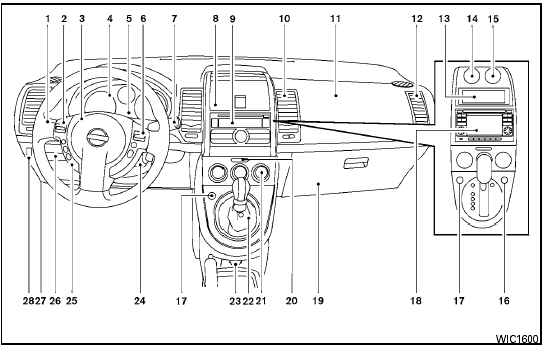Instrument panel

1. Headlight/fog light (if so equipped)/turn signal switch; Manual shift
paddles (if so equipped)
2. Steering wheel switch for audio control and Bluetooth Hands-Free Phone System
(if so equipped)
3. Driver’s supplemental air bag/Horn
4. Meters and gauges
5. Instrument brightness control
6. Cruise control main/set switches (if so equipped)
7. Windshield wiper/washer switch
8. Storage bin (if so equipped)
9. Audio system
10. Center ventilator
11. Passenger’s supplemental air bag
12. Side ventilator
13. Storage bin (if so equipped)
14. Engine oil pressure gauge (if so equipped)
15. g (gravity)-force gauge (if so equipped)
16. Hazard warning flasher switch (if so equipped)
17. Hazard warning flasher switch (if so equipped); Manual shift mode switch (if
so equipped)
18. Navigation system* (if so equipped)
19. Glove box
20. Front passenger air bag status light
21. Climate control
22. Shift selector
23. Power outlet
24. Ignition switch
25. Tilt steering
26. Storage bin
27. Hood release lever
28 Vehicle Dynamic Control (VDC) off switch (if so equipped)
* Refer to the separate Navigation System Owner’s Manual (if so equipped).
See also:
Overview
The Nissan Frontier, a no-compromise pickup forged with premium hardware,
extraordinary power and off-road athleticism, continues to be a leader in the
mid-size truck segment. Improving its alread ...
Install
1. Align the head restraint stalks with the holes
in the seat. Make sure the head restraint is
facing the correct direction.
2. Push and hold the lock knob and push the
head restraint down.
3. ...
Compact disc (CD) with MP3 or
WMA (models without Navigation
System)
Terms:
● MP3 — MP3 is short for Moving Pictures
Experts Group Audio Layer 3. MP3 is the
most well-known compressed digital audio
file format. This format allows for near “CD
quality” ...
